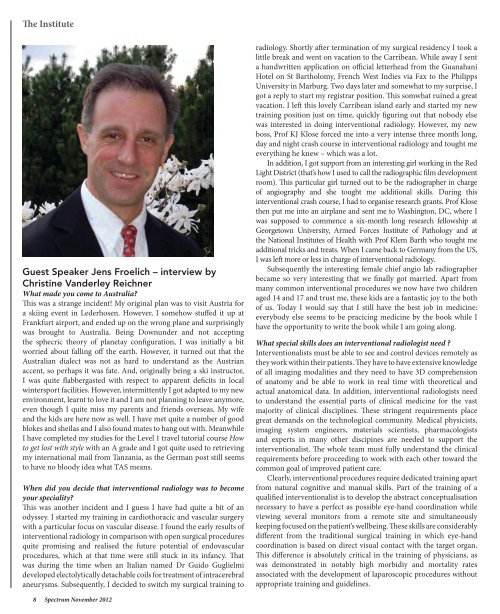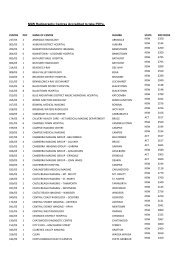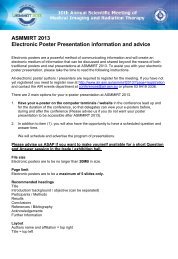The Institute Guest Speaker Jens Froelich – interview by Christine ...
The Institute Guest Speaker Jens Froelich – interview by Christine ...
The Institute Guest Speaker Jens Froelich – interview by Christine ...
Create successful ePaper yourself
Turn your PDF publications into a flip-book with our unique Google optimized e-Paper software.
<strong>The</strong> <strong>Institute</strong><br />
<strong>Guest</strong> <strong>Speaker</strong> <strong>Jens</strong> <strong>Froelich</strong> <strong>–</strong> <strong>interview</strong> <strong>by</strong><br />
<strong>Christine</strong> Vanderley Reichner<br />
What made you come to Australia?<br />
This was a strange incident! My original plan was to visit Austria for<br />
a skiing event in Lederhosen. However, I somehow stuffed it up at<br />
Frankfurt airport, and ended up on the wrong plane and surprisingly<br />
was brought to Australia. Being Downunder and not accepting<br />
the sphecric theory of planetay configuration, I was initially a bit<br />
worried about falling off the earth. However, it turned out that the<br />
Australian dialect was not as hard to understand as the Austrian<br />
accent, so perhaps it was fate. And, originally being a ski instructor,<br />
I was quite flabbergasted with respect to apparent deficits in local<br />
wintersport facilities. However, intermittently I got adapted to my new<br />
environment, learnt to love it and I am not planning to leave anymore,<br />
even though I quite miss my parents and friends overseas. My wife<br />
and the kids are here now as well. I have met quite a number of good<br />
blokes and sheilas and I also found mates to hang out with. Meanwhile<br />
I have completed my studies for the Level 1 travel tutorial course How<br />
to get lost with style with an A grade and I got quite used to retrieving<br />
my international mail from Tanzania, as the German post still seems<br />
to have no bloody idea what TAS means.<br />
When did you decide that interventional radiology was to become<br />
your speciality?<br />
This was another incident and I guess I have had quite a bit of an<br />
odyssey. I started my training in cardiothoracic and vascular surgery<br />
with a particular focus on vascular disease. I found the early results of<br />
interventional radiology in comparison with open surgical procedures<br />
quite promising and realised the future potential of endovascular<br />
procedures, which at that time were still stuck in its infancy. That<br />
was during the time when an Italian named Dr Guido Guglielmi<br />
developed electolytically detachable coils for treatment of intracerebral<br />
aneurysms. Subsequently, I decided to switch my surgical training to<br />
8 Spectrum November 2012<br />
radiology. Shortly after termination of my surgical residency I took a<br />
little break and went on vacation to the Carribean. While away I sent<br />
a handwritten application on official letterhead from the Guanahani<br />
Hotel on St Bartholomy, French West Indies via Fax to the Philipps<br />
University in Marburg. Two days later and somewhat to my surprise, I<br />
got a reply to start my registrar position. This somwhat ruined a great<br />
vacation. I left this lovely Carribean island early and started my new<br />
training position just on time, quickly figuring out that nobody else<br />
was interested in doing interventional radiology. However, my new<br />
boss, Prof KJ Klose forced me into a very intense three month long,<br />
day and night crash course in interventional radiology and tought me<br />
everything he knew <strong>–</strong> which was a lot.<br />
In addition, I got support from an interesting girl working in the Red<br />
Light District (that’s how I used to call the radiographic film development<br />
room). This particular girl turned out to be the radiographer in charge<br />
of angiography and she tought me additional skills. During this<br />
interventional crash course, I had to organise research grants. Prof Klose<br />
then put me into an airplane and sent me to Washington, DC, where I<br />
was supposed to commence a six-month long research fellowship at<br />
Georgetown University, Armed Forces <strong>Institute</strong> of Pathology and at<br />
the National <strong>Institute</strong>s of Health with Prof Klem Barth who tought me<br />
additional tricks and treats. When I came back to Germany from the US,<br />
I was left more or less in charge of interventional radiology.<br />
Subsequently the interesting female chief angio lab radiographer<br />
became so very interesting that we finally got married. Apart from<br />
many common interventional procedures we now have two children<br />
aged 14 and 17 and trust me, these kids are a fantastic joy to the both<br />
of us. Today I would say that I still have the best job in medicine:<br />
everybody else seems to be pracicing medicine <strong>by</strong> the book while I<br />
have the opportunity to write the book while I am going along.<br />
What special skills does an interventional radiologist need ?<br />
Interventionalists must be able to see and control devices remotely as<br />
they work within their patients. <strong>The</strong>y have to have extensive knowledge<br />
of all imaging modalities and they need to have 3D comprehension<br />
of anatomy and be able to work in real time with theoretical and<br />
actual anatomical data. In addition, interventional radiologists need<br />
to understand the essential parts of clinical medicine for the vast<br />
majority of clinical disciplines. <strong>The</strong>se stringent requirements place<br />
great demands on the technological community. Medical physicists,<br />
imaging system engineers, materials scientists, pharmacologists<br />
and experts in many other discipines are needed to support the<br />
interventionalist. <strong>The</strong> whole team must fully understand the clinical<br />
requirements before proceeding to work with each other toward the<br />
common goal of improved patient care.<br />
Clearly, interventional procedures require dedicated training apart<br />
from natural cognitive and manual skills. Part of the training of a<br />
qualified interventionalist is to develop the abstract conceptualisation<br />
necessary to have a perfect as possible eye-hand coordination while<br />
viewing several monitors from a remote site and simultaneously<br />
keeping focused on the patient’s wellbeing. <strong>The</strong>se skills are considerably<br />
different from the traditional surgical training in which eye-hand<br />
coordination is based on direct visual contact with the target organ.<br />
This difference is absolutely critical in the training of physicians, as<br />
was demonstrated in notably high morbidiy and mortality rates<br />
associated with the development of laparoscopic procedures without<br />
appropriate training and guidelines.
What procedure that you do, gives you the most pleasure?<br />
Generally the procedure that I don’t have to do because it is unneccessary<br />
and particularly on a Friday afternoon! Apart from that, it feels quite good<br />
to save lives, restore functionality and help people getting back on track. I<br />
personally love and prefer neurointerventional work. Mortality in patients<br />
with ruptured intracerebral aneurysms ranges between 50 and 70 per cent<br />
with a very high and devastating morbidity rate among the few survivors.<br />
I am well aware that it is not possible to save everybody’s life, it fulfills<br />
me with joy if I have been able to save a live without having to open the<br />
skull and expose the brain. Similar pleasure is obtained <strong>by</strong> saving a patient<br />
from developing a devastating stroke. However, every other successful<br />
procedure also gives me great satisfaction.<br />
How do you cope with the fact that not all your procedures will have<br />
a good outcome?<br />
Honestly? Pretty badly! Not uncommonly we are confronted with<br />
desperate clinical circumstances, where the alternatives are either “nothing<br />
more can be done” or only extreme therapeutic options are available. <strong>The</strong>se<br />
include death from exsanguination after arterial ruptures, continued<br />
neurological deterioration in cases of intracranial disorders, amputations<br />
in case of peripheral vascular disorders and progressive hepatic failure in<br />
hepatobiliary diseases. After considering these alternatives we frequently<br />
have to accept high risks and we try to find a compromise to suceed. This<br />
implies that there will be negative outcomes which then causes significant<br />
frustration and grief not only to the interventionalist but in particular to<br />
the patients and their families. Whenever there is a real risk for adverse<br />
outcomes, we try to communicate and liase with the patient’s family before<br />
getting into action or as soon as possible thereafter. Fortunately, I am in<br />
the lucky situation, that my family is always supporting me whenever I<br />
am desperate or very unhappy about an unsuccessful or complicated<br />
procedure.<br />
What procedures you do now, did you never think would become<br />
possible?<br />
When I had to watch my beloved Grandpa suffer and finally die<br />
from a large stroke at the age of 72, I was a young medical student.<br />
This was a terrible incident for me. All I could do was be with him<br />
and watch him pass away, without any possibility of helping. At that<br />
time I had no idea, that 15 years later I would personally have the<br />
knowledge and technology for saving his life. And this relates to most<br />
currently applied interventional and neurointerventional procedures.<br />
Technical developments and innovations have had an extremely<br />
rapid evolution: we can now replace aortic valves, place arterial<br />
<strong>by</strong>passes, repair the complete aorta, treat prostate hyperplasia, uterine<br />
fibroids, hepatic tumors, lung and bone tumors, repair vertebral body<br />
fractures, treat acute stroke, fix intracerebral aneurysms, myocardial<br />
infaction, generate transhepatic portosystemic <strong>by</strong>passes and occlude<br />
vessel injuries throughout the body rapidly without open surgery<br />
and frequently just under local anesthesia. If somebody would have<br />
told me about these possibilities 25 years ago, I would probably have<br />
thought that he or she has lost their marbles. I am pretty sure we will<br />
be even more impressed with our achievements after another 25 years.<br />
If you had a crystal ball, what do you think will be the next big<br />
breakthrough for an interventional radiologist?<br />
That would be the upcoming App release for the latest i-Phone called<br />
i-Fix. It will work similar to the i-Pod. <strong>The</strong> initial release will come<br />
with three registers: cardiovascular disease, oncology and neurodegenerative<br />
disorders. i-Fix consequently covers those diseases with<br />
the highest morbitity and mortality rates in our environment. All you<br />
have to do is open the i-Fix App, put the i-Phone on the diseased body<br />
part and press the Start button: Finished, problem fixed and solved!<br />
Wouldn’t it be nice to have that App?! Of course: currently such a<br />
vision seems to be impossile. But then back in 1985 did you think, you<br />
would be able to watch TV, receive e-mails and do interactive video<br />
conferences on your own tiny mobile telecommunication device kept<br />
somewhere in your pocket or handbag? Today I can already access the<br />
Radiology PACS system with my old i-Phone and I can indeed plug in<br />
an ultrasound transducer into this device to do an ultrasound exam.<br />
Doesn’t this look as if we’re going somewhere?<br />
<strong>The</strong> future of interventional radiology is extremely bright. As more<br />
innovative physicians, engineers and other interested parties become<br />
involved with our field, it is apparent that our imagination is the only<br />
limitation. <strong>The</strong> expansion of ideas continues and undoubtedly in this<br />
millenium techniques that are currently inconceivable, will soon be<br />
practised on a daily routine basis.<br />
We will hopefully soon see what happens to inhibit the<br />
problematic neointimal proliferation and thrombotic complications<br />
that can develop after percutaneous revascularisation and remodeling<br />
procedures. Initial current studies with drug-eluting balloons and<br />
stent have recently shown very promising results. Radioactive and<br />
bioabsorbable stents are also under investigation. Flow diverting<br />
devices have recently shown stunning results within cerebrovascular<br />
Yamba voted No. 1<br />
North Coast Town<br />
in NSW in 2010<br />
Opportunity for new radiologist<br />
business in area without this service<br />
• For lease with option to purchase property.<br />
Presently fully set up for medical practice.<br />
• 160m 2 of quality fitout (excludes medical<br />
equipment)<br />
• Building only completed four years and<br />
constructed to meet radiology needs.<br />
• Fully secured patient parking. Disabled friendly.<br />
Area population 17,000. Great lifestyle area.<br />
Two hours from Gold Coast.<br />
Larger floor area may be available if required<br />
Inquiries invited to<br />
Col McIlveen mob. 0410 467 226<br />
Email cmgrumbles@bigpond.com<br />
Spectrum November 2012 9
<strong>The</strong> <strong>Institute</strong><br />
applications and will soon offer fascinating treatment opportunities<br />
also in peripheral applications.<br />
Most certainly, nanotechnology will equip interventional<br />
radiology with completely new possibilities to manage malignancies<br />
endovascularly. A Nanotechnology treatment kit would likely include<br />
an inhibitor to specifically shut down growth and mitosis of cancer<br />
cells. <strong>The</strong> use of short interfering RNAs, seems to be particularly<br />
suitable to be attached to nanoparticle delivery platforms. MRIguided<br />
external magnetic localisation will likely be used to direct<br />
iron-based nanoparticles towards tumours in order to provide local<br />
thermotherapy. Recently radiofrequency ablation has been combined<br />
with doxorubicin nanoparticles to increase thermal ablation zones,<br />
and this technique is already in last phase clinical trials. Nanoparticles<br />
can also be used to carry certain new drugs, inhibiting the growth<br />
of tiny blood vessels that supply atherosclerotic plaques. Again, using<br />
endovascular techniques, these loaded nanoparticles can be directed<br />
to the site of new blood vessels within the base of atherosclerotic<br />
plaques. Activity can be maintained when components fastening the<br />
nanoparticles to cells found in newly developing blood vessels are used<br />
(= fellow nanoparticle passengers). Fixed in position, the nanoparticle<br />
can drop its drug load to concentrate within the atherosclerotic<br />
plaque to generate plaque absorption. Alone or in combination<br />
with nanoparticles, gene-therapy will also almost certainly change<br />
and improve current treatment approaches for the majority of<br />
arteriosclerotic, neoplastic and neurodegenerative disorders. Gene<br />
therapy is transferring recombinant genetic material (DNA or RNA)<br />
to the host cell in order to change tumour related gene expressions.<br />
10 Spectrum November 2012<br />
Interventional techniques will offer a fantastic targeted application<br />
method for these gene and Nanoparticle vectors in order to assure<br />
high focal efficacy and low systemic side effects.<br />
Your greatest wish as an interventional radiologist?<br />
One thing that will certainly change is the discipline of our field. It<br />
is very unlikely that ‘interventional medicine’ will be so narrow to<br />
be considered interventional radiology much longer. <strong>The</strong> use of<br />
multiple imaging modalities, shared <strong>by</strong> a variety of disciplines, such as<br />
surgery, cardiology and radiology will make the field of interventional<br />
medicine considerably broader than it is today. Additionally, other<br />
imaging modalities which have traditionally not been included within<br />
a radiology environment may become increasingly utilised, such as<br />
endoscopic and other video-based techniques.<br />
I share the opinion of most interventional fellows, that we still<br />
stand at the threshold of the development of our discipline, despite its<br />
previous dynamic history of more than 20 years. <strong>The</strong> characterisation<br />
of the interventionalist must continue being driven <strong>by</strong> improvement<br />
of the status quo, and continuously strive to find lesser invasive and<br />
more cost effective therapies.<br />
Just recently, the large European and North American radiologic<br />
and interventional societies have taken the first step in this process and<br />
acknowledged Interventional Radiology as its own speciality, which in<br />
my opinion was more than overdue. I hope that Australia will soon<br />
follow this example and will realise the tremendous potential of this<br />
discipline with regards to dedicated funding, research cooperation<br />
and with its own clinical patient management. s




